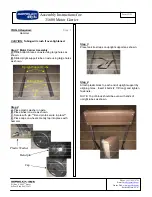
TVME8300 User Manual Issue 1.4
Page 22 of 70
3.5.6 Fuse Register
Bit
Name
Access
Reset
Function
0
(MSB)
FUSE_IPAB5 R
-
0 : Fuse IP Slots A/B 5V OK
1 : Fuse IP Slots A/B 5V Triggered
1 FUSE_IPCD5
R
-
0 : Fuse IP Slots C/D 5V OK
1 : Fuse IP Slots C/D 5V Triggered
2 FUSE_IP12P
R
-
0 : Fuse IP Slots +12V OK
1 : Fuse IP Slots +12V Triggered
3 FUSE_IP12N
R
-
0 : Fuse IP Slots -12V OK
1 : Fuse IP Slots -12V Triggered
4
Reserved
-
-
Undefined for Reads
5
6
7
(LSB)
Reserved
-
-
Undefined for Reads
Figure 3-13: Fuse Register
All board fuses are recoverable fuses.
3.5.7 Utility Register Interrupts
There are two interrupt sources under Utility Registers control. Both interrupt sources are mapped to a
single Utility Interrupt Source which is part of the MPC8245 PIC Serial Interrupt Map. When any bit in
the Interrupt Register is set, the Utility Interrupt is active.
•
User
Interrupt
To assert a user interrupt, set the USR_INT bit in the Interrupt Register. Write ‘0’ to the USR_INT
bit to clear the user interrupt.
•
Fuse
Interrupt
The FUSE_INT_EN bit in the Control Register controls whether an active fuse status is latched
into the FUSE_INT bit in the Interrupt Register. Write ‘1’ to the FUSE_INT bit in the Interrupt
Register to clear a latched fuse interrupt. Disabling the fuse interrupt does also clear the fuse
interrupt.
The fuse status register bits reflect the actual fuse status (unlatched). So when the fuse recovers
before the interrupt service routine reads the Fuse Status Register, it is possible that the interrupt
service routine finds all fuse status bits clear.
If a fuse interrupt occurs, this should be indicated to the system and the fuse interrupt should be
disabled (otherwise there may be permanent fuse interrupts as long as the overload situation
exists).















































